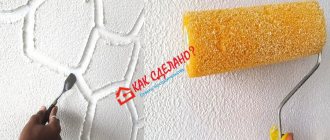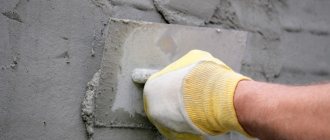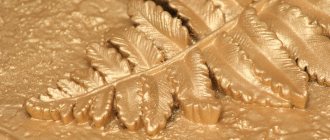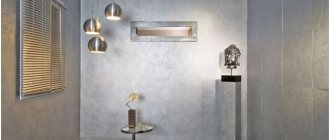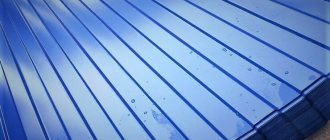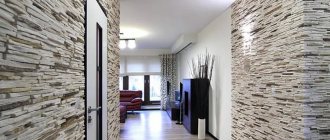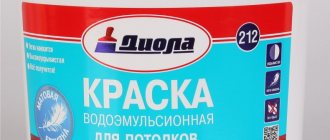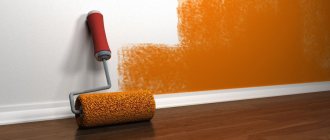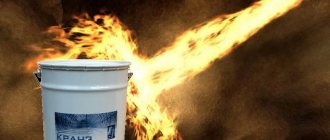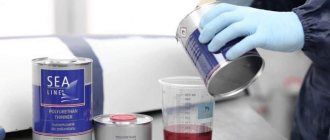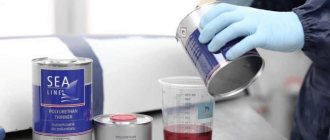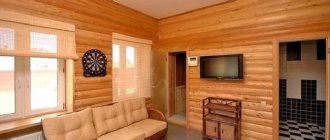Textured paint is an alternative to decorative plaster, but it is applied in a thinner layer. The finished finish is a surface with a pattern or relief. They achieve imitation of leather, brick, stone, concrete and wood. The base is the same components as the regular mixture, but with a thicker consistency and various solid additives. It has good wear resistance and easily withstands any environmental influences.
Differences from decorative plaster
Relief-forming particles are smaller in size - 0.2 versus 1.0 mm. Textured patterns on painted facades are more subtle and neat. The binding component is more flexible, making the application process easier. But there is practically no need to prepare walls for plastering, whereas leveling and priming are required for painting.
Characteristics and composition of textured paint
The texture compositions of different brands differ in thickness. The paint itself has a high density and contains polymers and acrylic. To obtain a thick and elastic mixture, modified starch is used.
Manufacturers also add to the mixture:
- Quartz sand;
- Fine grain marble;
- Granite chips;
- Polymer fibers;
- Gas silicates.
In construction stores you can find a huge number of painting compounds from different manufacturers. They are suitable for both indoor and outdoor use. Some types can be used to finish the facade on top of the cladding.
The drying speed of the mixture is increased by acrylic polymer particles. During operation and subsequent drying, no unpleasant odor appears in the room.
Advantages of painting with a textured mixture
The advantages of textured paint are due to its composition - no solvents or acetone are used in production, which avoids the appearance of an unpleasant odor.
The main advantages of paint:
- Does not contain harmful and toxic components and impurities, so its use does not affect health in any way;
- Due to the fact that the mixture has a thick consistency, you can work with it even without gloves;
- Perfect alignment of the walls is not required - after applying the composition, small cracks and light defects will be hidden;
- Painting walls does not affect the microclimate in the room and does not impair air circulation;
- The coating can withstand high humidity, sudden temperature fluctuations, and is also resistant to the development of fungus;
- Modern manufacturers produce compositions that prevent fire and do not emit toxic substances when heated.
Silicone
Previously, these paints were called water-based paints in everyday life; they were the first to replace oil dyes. The interior walls could be washed. We reinforced it with components for durability on the outside of buildings.
Silicone doesn’t care about rain water outside, which is important for walls. Silicone paints for facades have advantages over others.
A number of other advantages:
- mechanically little damaged;
- vapor permeable;
- temperature changes do not harm;
- ultraviolet does not pass through;
- No static tension is created and dust is not attracted.
Water-based facade paints have good adhesiveness (sticking) to various building surfaces.
Disadvantages: overly elastic coating than acrylic resins. Expensive material.
Disadvantages of textured finishes
When choosing a paint with a plaster effect, you need to take into account the characteristics of the composition and how to work with it.
- The consumption of textured paint is higher than regular paint, so you need to correctly calculate the quantity and cost of the mixture.
- Dense layers dry in 5-6 hours at a temperature of about 25 degrees. While the coating is drying, it is strictly forbidden to open doors and windows to avoid peeling of the material.
- Before painting the damaged area, you need to dismantle the old coating and choose the right shade so that it does not differ from the previous one.
Despite some disadvantages, textured paint is a fairly popular finishing material. Beginners are captivated by the ease of working with it: you can paint walls without any experience. To complete the finishing you will not need any special tools or equipment.
Painting methods
It is quite easy to do decorative painting with your own hands. First you need to prepare a wall, ceiling, facade or other area for use. It needs to be cleaned, old coatings removed, cracks sealed and leveled. After this, you need to coat the surface to be treated with a primer and let it dry completely. After this, you need to make sure that the temperature in the room where the textured red will be applied will not be lower than +7 ° C; if the air is colder, the consistency of the dye will become viscous and the application process will be extremely difficult.
Next we begin the painting process. On the leveled and prepared material, apply a layer of paint with a spatula. After this, we begin to create a structural layer using various tools, it all depends on what texture you want to imitate. We use either a roller, a stencil, or a Teflon spatula. As soon as the first layer is completely dry, we proceed directly to painting the textured surface in the selected color.
DIY paint applied to the ceiling
In addition to simple painting, the surface can be coated with transparent varnish with special additives - creative pastes. This solution will give an unusual effect, namely, glare and reflections of light and objects will look different depending on the viewing angle.
Features of paint consistency
Unlike enamel and oil mixtures, textured paint has a thick consistency, due to which it is evenly distributed over the surface. To get a high-quality and durable coating, it is enough to apply the mixture in two layers.
The task of finishing with textured paint is to create a surface with an original design and an unusual, complex relief. Components such as fine sand and granite chips help give the coating an interesting texture.
Chip paint can be used for both exterior and interior work. With its help it is possible to imitate natural granite or marble. To apply such mixtures, use a stiff brush or small roller.
Necessary tool
In addition to the coloring composition itself, you can use the following tools for work:
Set of necessary tools
- Brush
- Different spatulas, both in size and the material from which they are made
- Roller or stencil
- Spatula or comb
- Sponge
- Aerosol spray
The topic of applying textured paint using all of the above methods deserves special attention. Now we will voice only brief excerpts. Working with a brush consists of creating beautiful paintings on an already frozen first layer, or we use a brush to form the relief of the first layer. According to the decorative technique, we first apply horizontal stripes, then proceed to the vertical ones. Working with a roller involves transferring an image from the tool to the wall. A wrapped rope or fabric can act as a relief on the roller, or buy a ready-made one in a store. Before passing with a roller with a textured working side, it is better to apply a base coat of paint to the wall, ceiling, facade or other surface. We use a spatula and comb to create streaks. You can make a texture spatula yourself by cutting out the necessary holes in the working die. A sponge is good for working on a stencil. A pneumatic sprayer is good for large volumes of decoration.
Types of compositions
For interior work, you can use a huge number of textured mixtures, which differ not only in color palette, but also in composition.
Among the most popular textured paints there are several types.
- Missouri. Manufacturers use acrylic fillers, as well as modified starch, to make this paint. With the help of such compositions it is possible to obtain a relief coating with a wave-like pattern, which is created with a special roller. Pigments can be added to the mixture to add a glossy shine to the finished coating. The peculiarity of this composition is that it can be carried even by hand.
- Marseille wax. The composition is based on wax and polymer fillers. This paint dries quickly, allowing you to create the effect of aged natural stone with a pattern that imitates natural stone when applied. A properly dried coating has a glossy shine. The paint can be used to decorate different rooms - imitation of natural stone can elevate any interior.
- Wet silk. This mixture uses cotton fibers and cellulose. The polymer base in combination with high-quality pigments allows you to obtain a rich color and pronounced texture. The finished coating resembles velvet or velor fabric: with it you can create an atmosphere of real luxury.
What does it look like in the interior?
The scope of application is extensive. They mainly decorate walls in living rooms, bedrooms, and hallways. But the compositions, resistant to water and washing, are also suitable for kitchens and even bathrooms.
The photo shows imitation rust in loft style
The solution is selected according to the style of the interior: complex Marseille wax will be an excellent backdrop for classic carved furniture or chic Empire and Baroque styles. A more restrained modern style would be suitable for Mizuri in a light neutral shade: white, gray, beige.
In the loft style, atacama would be appropriate: the roughness can imitate concrete, plaster or rust on metal.
The second important factor is the functionality of the room. For children's rooms, choose colored pastels on all walls. Either one of the surfaces is made bright, accent, and the rest are light. Flat “warm” effects are suitable: silk, paper.
In bedrooms, the coverings should be neutral, but it is permissible to play with volume: make pleasant mizuri waves or add the relief of a fur coat or lamb.
For the kitchen, the less relief, the better: dust, dirt, and grease will accumulate on the ledges, which are not easy to clean.
The room where there are no restrictions is the living room. Volume and flatness, bright and calm shades, glossy and matte effect are appropriate. Textured paint is selected according to size: the smaller the room, the lighter and shiny the coating should be.
Using textured paint is always an experiment! It is almost impossible to predict what exactly will happen in the end. But a little skill and a little imagination will help you achieve an excellent result!
Preparing walls for application
To carry out the finishing, it is absolutely not necessary to invite specialists: even a novice in painting can handle the work. Finishing putty is not needed, and small external defects in the walls can be corrected using a building mixture - it can be applied to an untreated surface.
Before application, the walls are cleaned of dirt and dust. To ensure that the paint is distributed evenly, it is best to clean the surface with a soap solution. Using a primer improves the adhesion of the material to the concrete surface.
Working with textured paint
Painting the walls is done in stages.
- First of all, the mixture needs to be stirred for several minutes, adding a color that is sold in special hardware stores. You can also purchase a ready-made composition. By adding pigment yourself, you can control the intensity of the shade.
- The composition is applied to the walls using a construction spatula.
- An original pattern is created with a special roller.
- Each layer is allowed to dry for an hour.
If necessary, after the layers have completely dried, additional protective wax is applied to extend the service life of the coating.
Creating an invoice
The scope of use of textured plaster is unlimited - it is used not only for decorating walls, but also for decorating various architectural elements (from columns and niches to door arches and other structures). The texture on the surface can be created using either a specialized tool or improvised means.
We will look at the main ways to create a texture below.
Roller
You can create a specific pattern or ornament on freshly applied plaster using various rollers:
- Relief – produced with depressed and protruding relief.
- Fur – provide the opportunity to create a decorative “Fur Fur” effect.
- Made from soft, crinkled fabric - they allow you to create an imitation of a marble surface, provided you use a suitable mixture and paint the walls using a special technology.
Figure 1. Different types of rollers for creating the texture of a plastered surface
Stamps, stencils
Such devices allow you to create a pattern even in the absence of any plastering skills. To create a pattern, simply press the prepared stamp or stencil into a layer of plaster that has been freshly applied to the wall. But it is worth considering that this tool must be frequently moistened with water to obtain a high-quality result.
Photo 11. Complex patterns and ornaments on the surface are made using stencils and stamps
Trowel
The use of a trowel and other improvised tools (for example, brushes, spatulas, ordinary sponges or plastic bags) requires imagination and a certain skill on the part of the performer. One of the easiest textures to implement is “wild stone”. To obtain it, strokes are applied randomly with a spatula or trowel on the plaster layer that has not yet set.
Photo 12. Formation of texture using a trowel
